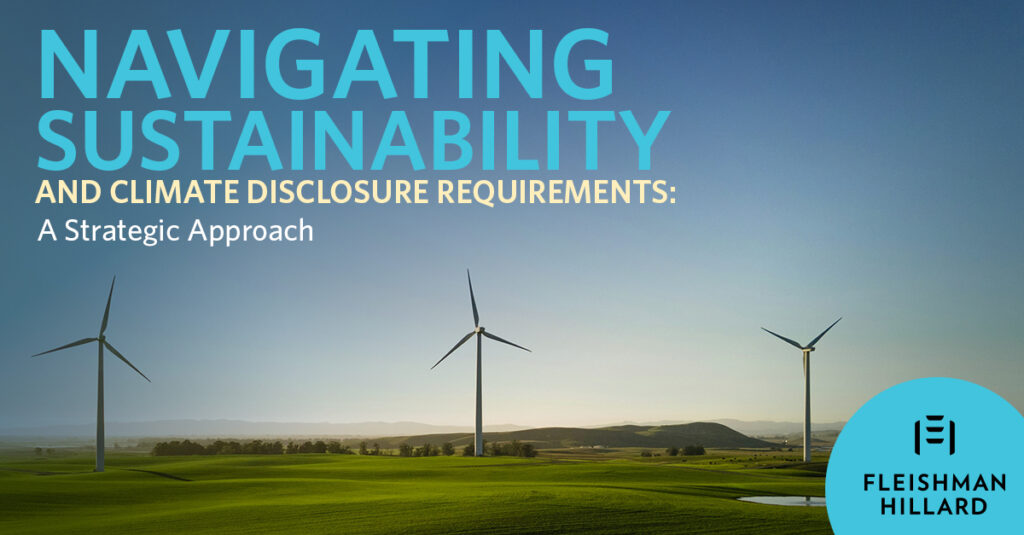Navigating Sustainability and Climate Disclosure Requirements: A Strategic Approach
In today’s business landscape, companies are increasingly recognizing the importance of understanding sustainability issues and effectively reporting them to stakeholders. With recent regulatory changes and growing investor demand for climate-related information, public companies and financial institutions find themselves at the crossroads of both exciting opportunities and formidable obstacles ahead.
The postponement of the implementation of IFRS S1 and S2 for Hong Kong listed companies to 1 January 2025, as announced by The Stock Exchange of Hong Kong, along with the introduction of new standards by The Hong Kong Monetary Authority regarding the sale and distribution of green and sustainable investment products by registered institutions, has produced a fresh array of opportunities and challenges for public companies and financial institutions in Hong Kong and the region.
In a similar vein, the United States has also taken significant steps towards climate-related disclosures. On March 6, 2024, the U.S. Securities and Exchange Commission enacted rule changes mandating companies to divulge specific climate-related information. These disclosures encompass a wide range of aspects, spanning from greenhouse gas emissions to anticipated climate risks and transition plans. The overarching objective of these requirements is to equip investors with consistent, comparable, and consequential information to facilitate informed investment decisions, while concurrently establishing clear and uniform reporting obligations for issuers. Additionally, there would be extra territorial rules applying to European companies outside of the EU as well.
Given this evolving regulatory landscape, the question arises: How can public companies (global or local) and financial institutions effectively prepare for these upcoming requirements in Hong Kong and the region?
Five steps to prepare for sustainability and climate disclosure requirements
Following the adoption of different rules pertaining to sustainability and climate disclosure, public companies and financial institutions are under huge pressure to accelerate their efforts to capture, measure and disclose emissions data.
1. Conduct a Comprehensive Audit
To kickstart the journey towards sustainability and climate disclosure, it is crucial for companies to conduct a thorough audit. This audit should encompass quantifying greenhouse gas (GHG) emissions across the company’s operational footprint and identifying the most material sustainability issues. While this process may pose challenges in emerging markets, initiating the audit early on allows for the formulation of effective disclosure strategies.
2. Perform a Holistic Assessment
Having completed an audit, companies need to then understand asset-level physical risks and quantify their financial impact and evaluate the business impact of climate transition risks. By conducting scenario mapping exercises, organizations can assess the potential effects of both physical and transition risks. This comprehensive assessment aids in developing robust business, operational, and communication strategies.
3. Set Science-Based Targets and Metrics
It is essential for companies to establish science-based targets for emissions reductions and align their efforts with various jurisdictions and requirements. These targets should be tangible and achievable to facilitate benchmarking against industry peers.
4. Strengthen Communications and Trainings
Engaging stakeholders, including customers, partners, investors, and employees, is crucial in the sustainability and climate disclosure journey. Proactive communication efforts should be undertaken to ensure transparency and build trust. Additionally, organizing internal training programs equips employees to become ambassadors for sustainability, fostering a culture of environmental responsibility within the organization.
5. Continuous Evaluation and Reporting
Sustainability and climate disclosure is an ongoing process, requiring constant evaluation and reporting. Regularly assessing performance helps identify any gaps and ensures compliance with evolving international standards. Staying ahead of the latest requirements and industry developments is vital to meet the expectations of global stakeholders.
As sustainability and climate-related issues continue to gain prominence, public companies and financial institutions must adapt and embrace the changing landscape. By following these five essential steps—conducting audits, performing assessments, setting targets, strengthening communications and training, and continuous evaluation and reporting—organizations can navigate the complexities of sustainability and climate disclosure requirements effectively. Embracing these practices not only supports regulatory compliance but also enhances your reputation, attracts investors, and contributes to a more sustainable future.

